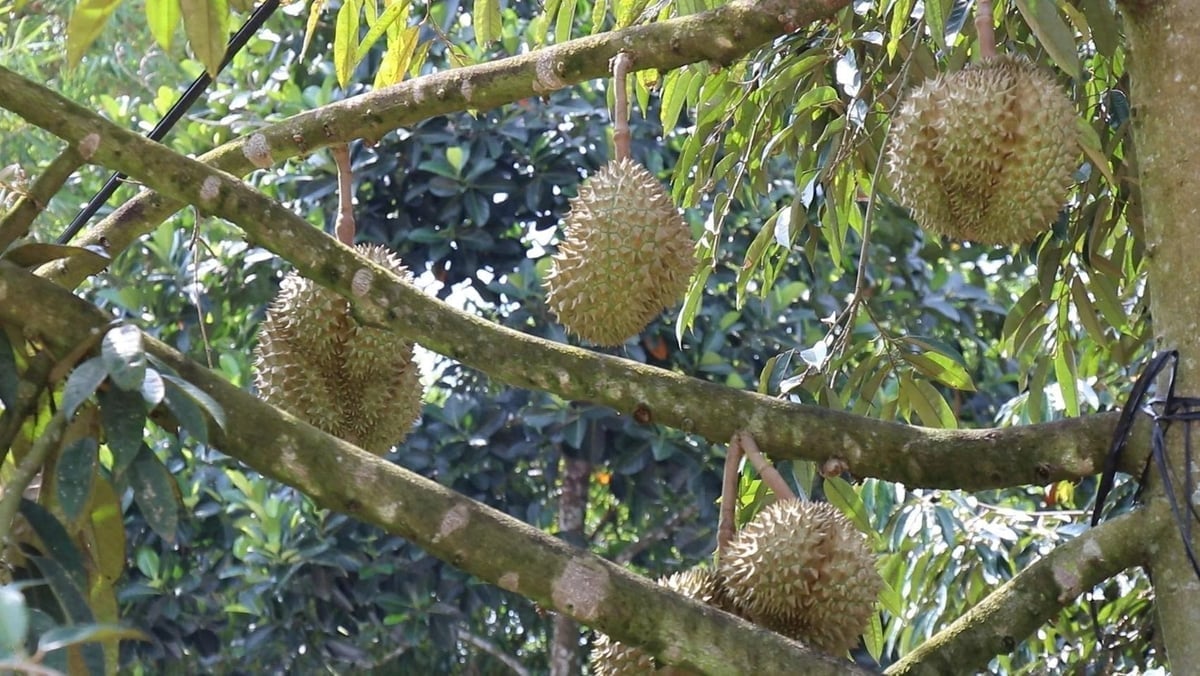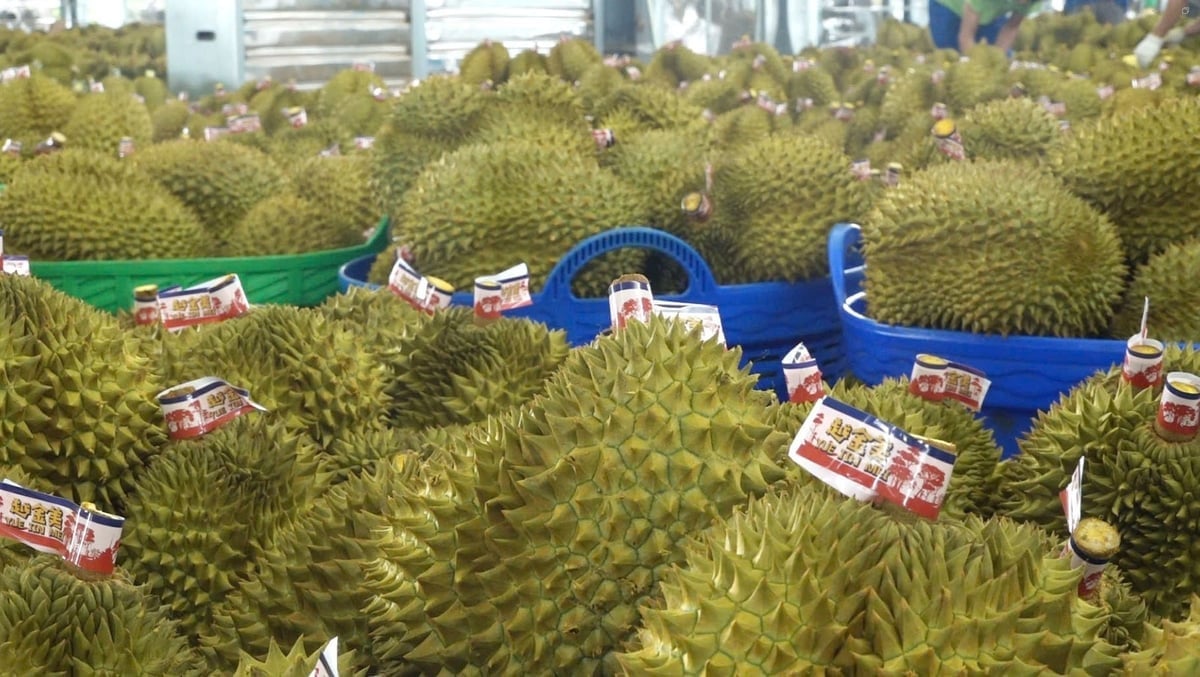October 31, 2025 | 01:16 GMT +7
October 31, 2025 | 01:16 GMT +7
Hotline: 0913.378.918
October 31, 2025 | 01:16 GMT +7
Hotline: 0913.378.918

In recent years, provinces in Central Highlands have promoted the granting of planting area codes, the establishment of standardized packing facilities, and the dissemination of safe durian farming practices to farmers. Photo: Phuong Chi.
In the 2025 season, Central Highlands continues to affirm its position as the country’s leading durian-growing region, with an area of over 90,000 hectares and an estimated output of about 700,000 tons. This remarkable figure reflects the strong development of a crop that brings high economic value to farmers on the basalt soil while also making an important contribution to the country’s fruit and vegetable export turnover.
The unique competitive advantage of Central Highlands durian lies in its distinct seasonal advantage compared to other growing regions. Thanks to the highland climate, the harvest time of Central Highlands durian does not overlap with major domestic production areas such as the Southeast region. More importantly, its harvest season also does not coincide with Thailand, the world’s largest durian exporter.
This advantage gives Central Highlands durian its own position in the international market. When supplies from Thailand and the Southeast region decrease, Central Highlands durian enters its peak harvest season, allowing prices to remain high and stable. This is an important factor for farmers to increase profits, for exporters to proactively secure supply, and for the formation of a distinctive brand identity for Central Highlands durian.
However, product quality remains the key factor for Central Highlands durian to develop sustainably and affirm its long-term position in the export market. In recent years, localities have increased their efforts to grant planting area codes, build standardized packing facilities, and promote safe farming practices among farmers.
Industry associations, export enterprises, and farmers are working together to maintain the quality of Central Highlands durian through multiple measures: applying VietGAP standards, ensuring food safety, limiting overuse of pesticides, prioritizing organic fertilizers and biological products to improve soil durability, while strengthening production linkages, signing off-take contracts to secure stable outputs.

Dak Lak develops a "green lane" durian export chain from farm to table to meet the strict requirements of international markets. Photo: Phuong Chi.
In particular, specialized agencies emphasize building the Central Highlands durian brand associated with geographical indications and traceability. This is considered a “passport” that helps the product maintain its position in the Chinese market and expand into high-standard markets such as Japan, South Korea, the EU, and the US.
After the merger, Lam Dong became one of the provinces with the largest durian area in the country, nearly 44,000 hectares. More than 22,000 hectares will be harvested in 2025, with an output of about 267,000 tons. To improve quality, the province has implemented various measures, in which the Lam Dong Department of Agriculture and Environment has strengthened strict supervision from production, harvesting, preliminary processing, and packaging to export.
Mr. Nguyen Hoang Phuc, Deputy Director of the Lam Dong Department of Agriculture and Environment, said that durian is a commodity strictly controlled for food safety, and just one shipment being flagged could affect the reputation of the entire industry. Therefore, Mr. Phuc requested localities to strengthen communication on safe farming, use fertilizers and pesticides in accordance with regulations, minimize cadmium and lead residues, and absolutely avoid using Auramine O. Stakeholders must purchase only from planting areas granted codes, establish traceability systems, and control heavy metals as well as harmful organisms.
The province has proposed that the Ministry of Agriculture and Environment support the construction of a standardized testing laboratory locally to reduce enterprises' costs and time. It will soon issue mechanisms for inter-provincial coordination in managing out-of-province enterprises using Lam Dong’s planting area codes.

Export durian prices in Central Highlands have started to rise again, with farm-gate prices for grade 1 (export quality) ranging from VND 75,000 to VND 80,000 per kilogram. Photo: Phuong Chi.
Dak Lak, with nearly 40,000 hectares and an estimated output of over 400,000 tons in 2025, is also implementing decisive measures to improve quality to meet international market requirements, especially China. The Dak Lak Durian Association has coordinated with the Department of Agriculture and Environment, enterprises, cooperatives, and farmers to establish and operate a “green lane” export chain, aiming to meet traceability and food safety requirements fully. This model helps shorten customs clearance procedures, facilitate export activities, and enhance the reputation and brand value of Vietnamese durian.
The strategy focuses on applying comprehensive traceability technology and quality control at each stage, in which laboratories play an important role before goods leave the orchards.
Currently, testing centers under the Directorate for Standards, Metrology and Quality, including QUATEST 4 located in Dak Lak, have been recognized by more than 110 countries under the mutual recognition arrangement for test results. This is an advantage for QUATEST 4 to represent the Directorate in providing traceability, testing, and inspection services to enhance productivity and quality of durian.
Mr. Nguyen Huu Trung, Director of QUATEST 4, said that the center is fully capable of testing prohibited residues for durian exports at orchards, planting areas, packing facilities, and export shipments, with a capacity of about 100 samples per day. The system has been equipped with atomic absorption spectrophotometers and high-performance liquid chromatography-mass spectrometry to control heavy metals, organic compounds, and banned substances.
“With current capacity, QUATEST 4 and other units in the system are capable of controlling all factors related to cultivation, processing, and deep processing of durian in particular and agricultural products in general,” Mr. Trung affirmed.
In recent days, export durian prices in Central Highlands have risen again, with orchard purchase prices for grade 1 durian (for export) ranging from VND 75,000–80,000 per kilogram. This is a positive signal for the durian industry. Statistics from the first seven months of the year show that durian export turnover is estimated to surpass USD 1 billion.
* $1 = VND 26.520 - Source: Vietcombank.
Translated by Huong Giang

(VAN) Viet Nam mainly exports raw Bat Do bamboo shoots for deep processing, so premium products appear only on dining tables in Japan and Taiwan.

(VAN) Tafa Group CEO emphasized, 'It is essential to strengthen communication efforts so that 'Made in Vietnam’ egg brand not only maintains a strong foothold domestically but also reaches into export markets.'

(VAN) Building on its leading position, Ho Chi Minh City drives a green, digital, and creative wood industry toward global reach and its goal of joining the world’s top 100 most livable cities by 2045.
/2025/10/25/0325-1-nongnghiep-130321.jpg)
(VAN) The 2024–2025 crop year of Viet Nam's coffee industry has ended with record export turnover of USD 8.4 billion. Since the beginning of this year, exports have already surpassed USD 7 billion.

(VAN) Vietnam and Chile are seeing opportunities to deepen their agricultural cooperation, especially as both share a common vision of sustainable development and trade integration.

(VAN) Strong export growth across industries drives Phu Tho’s economic breakthrough and contributes to achieving overall growth goals.

(VAN) During the first 7 months of 2025, Russia boosted its share of Chinese poultry imports to a record 18%, up from 14% the previous year.